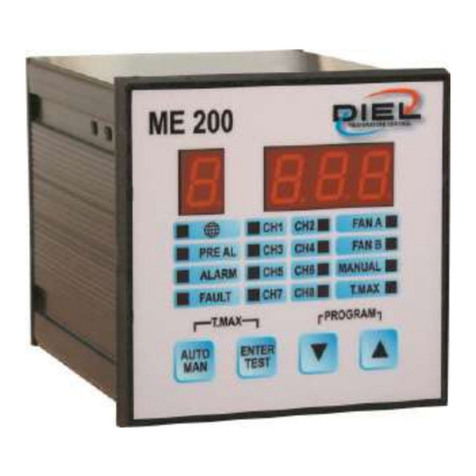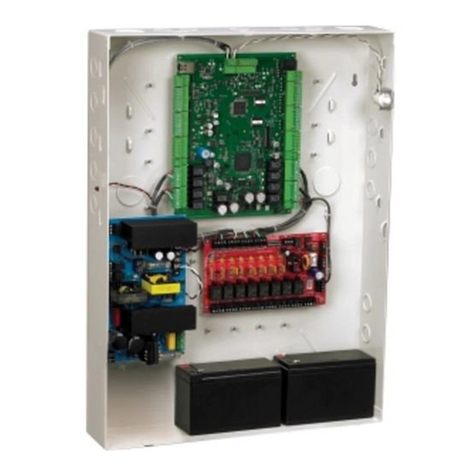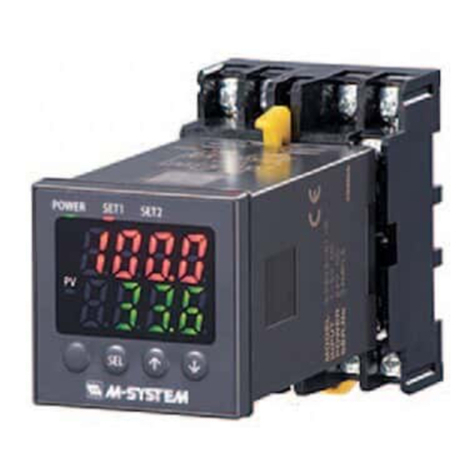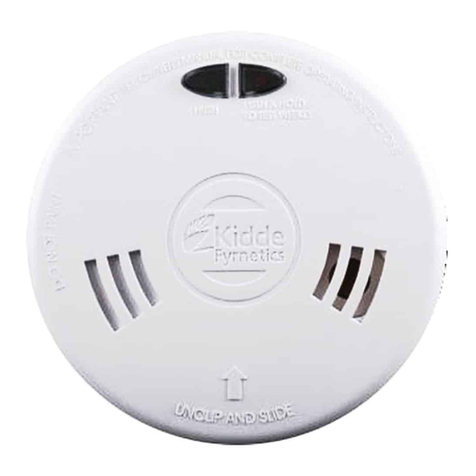ERNITEC 225 Stries Guide

Installation and Adjustment Instruction for
BVT-225, BVR-225 & BVX-225
1 Introduction
The following units are covered in this manual:
The boxed video transmitter BVT-225
The boxed video receiver BVR-225
The boxed video repeater BVX-225.
All three units are fully compatible with other Ernitec twisted pair video equipment. However, the
specified transmission distance assumes the use of Series 225 equipment only.
1.1 Twisted Pair Video Transmitter BVT-225
The BVT-225 is a video transmitter for twisted pair cables housed in an IP 65 rated ABS-box. One
unbalanced video output for 75 Ωcoaxial cables are available; the output can be used
simultaneously if the video needs to be supervised from a local monitor. This feature might
eliminate the need for a video distribution amplifier.
The following settings are available: Selection of cable impedance, selection of output voltage on
the unbalanced and the balanced video output. The transmitter output is galvanically separated
from the twisted pair input in order to avoid ground loop problems.
The BVT-225 is mains supplied and is equipped with a mains change-over switch for selection
between 230 VAC and 115 VAC mains voltage.
1.2 Twisted Pair Video Receiver BVR-225
The BVR-225 is a video receiver for twisted pair cables housed in an IP 65 rated ABS-box. Two
unbalanced video outputs for 75 Ωcoaxial cables are available; both outputs can be used
simultaneously if the video needs to be supervised from two locations. This feature might eliminate
the need for a video distribution amplifier.
The following settings are available: Selection of cable impedance, unbalanced video output,
voltage adjustments and five different frequency adjustments.
The BVR-225 is mains supplied and is equipped with a mains change-over switch for selection
between 230 VAC and 115 VAC mains voltage.
1.3 Twisted Pair Video Repeater BVX-225
The BVX-225 is a video repeater, i.e. a combined video transmitter and video receiver for twisted
pair cables housed in an IP 65 rated ABS-box. On the receiver part of the BVX-225 two unbalanced
video outputs for 75 Ωcoaxial cables are available; both outputs can be used simultaneously. The
transmitter output is galvanically separated from the twisted pair input in order to avoid ground
loop problems.
The BVX-225 is mains supplied and is equipped with a mains change-over switch for selection
between 230 VAC and 115 VAC mains voltage.
2 Installation
Coaxial- and twisted pair cables can be connected to and removed from the units, although mains
voltage is connected.
Note: The stated approvals and specifications are valid only if the equipment is installed according
to the instructions contained in this manual.
Twisted pair video equipment Series 225
2800-00054

2.1 Box installation
Choose a plain surface to prevent the box from being twisted and thereby becoming leaky while
mounted. When mounted out-door the box should be oriented with the cable glands pointing
downwards.
Screws and wall plugs are supplied in the mounting kit. Drilling dimensions are shown on the
figures at the end of this manual.
2.2 Mains installation
The BVT-225, BVR-225 and the BVX-225 can be supplied with either 115 VAC or 230 VAC mains
voltage. The mains voltage is selected by the mains voltage change-over switch, refer to the
figures. The connection of the mains cable is also shown on the figures.
Terminals marked with hazardous live symbol requires installation by an instructed person.
The BVT/R/X-225 must be used with a 3-wire mains connection (2W+PE @ min. 0,75mm2).
Details on the mains supply can also be found on a label fitted inside the lid of the BVT/R/X-225.
Terminals marked with hazardous live symbol requires installation by an instructed person.
If permanently connected to mains, a readily accessible disconnect device shall be incorporated in
the building installation wiring.
If pluggable connection to mains, the socket-outlet shall be installed near the equipment and shall
be easily accessible .
In order to fulfil the safety standard (IEC 60950), the mains cable must be routed via the provided
cable clip inside the Series 225 box. Figure below shows how the mains cable should be routed.
Warning: Before connecting the unit to the mains outlet make sure that the mains voltage
change-over switch is set for correct mains voltage in order to avoid damage on the equipment.
Warning: Make sure the equipment is earthed; otherwise the over voltage protection will not
work! Although both the transmitter and the receiver are earthed no ground loop problems will
occur due to the galvanic separation of the video signal introduced in the transmitter.
2.3 Video cable connections
Connect the cables exactly as shown on the figure. The unbalanced outputs on all three units can
be used simultaneously.
Note: If any of the unbalanced outputs are unused make sure to leave the factory fitted
termination load in position for optimum performance.
Warning: At the transmitter end do not in any way connect the twisted pair shield. If the shield is
connected to the transmitter the galvanic separation will not work!
The shield should be connected at the receiver end only.
Twisted pair video equipment Series 225
2800-00054
Mains terminal block
Cable clip
Mains cable
Mains cable

3 Adjustment
The best performance is obtained by connecting a greyscale/mulitiburst video generator to the
video transmitter BVT 225 and oscilloscope and a monitor to the receiver or the receiver part of the
BVX-225. On the receiver check that H1 line status indication (green LED) is flashing. The yellow
LED H2 indicates power.
If a negative or turned over picture is displayed on the monitor, the twisted pair cable should be
reversed at the receiver input terminal X1.
If the transmission line includes a BVX-225 repeater, the two twisted pair lines should be treated as
two individual twisted pair lines - the only issue to be considered is the order in which the individual
units are adjusted:
1. Video transmitter BVT-225.
2. Receiver part of BVX-225.
3. Transmitter part of BVX-225.
4. Video receiver BVR-225.
Several BVX-225 repeaters can be inserted in a line to extend the transmission distance further.
However, a certain decrease of video quality must be expected.
3.1 Cable impedance settings
The cable impedance setting should be set in accordance with the characteristic impedance of the
twisted pair cable used in order to avoid signal reflections (shadows in the picture).
Cable impedance
BVT-225 & BVX-225 switch S1
Cable impedance
BVR-225 & BVX-225 jumper W1
Pos. Description Position Description
H124 Ωfor 90-140 Ωcables 124 (pins 1-2) 124 Ωfor 90-140 Ωcables
L62 Ωfor 50-70 Ωcables 62 (pins 2-3) 62 Ωfor 50-70 Ωcables
3.2 Setting of unbalanced output voltage for BVT-225
It is possible to choose between two values for unbalanced output voltage:
Unbalanced output voltage:
BVT-225: jumper W2
Pos. Pin no. Output voltage Cable length (approx.)*
1.0 1-2 1.0 Vpp linear <150m
2.0 2-3 1.2 Vpp, +2 dB @ 5 MHz <300m
*Note: These settings are determined using the cable type: RG59
3.3 Initial setting for BVT-225 and BVX-225
Under normal circumstances the setting mentioned below only need to be set when the transmitter
or the repeater is installed. However, if the cable quality is either very high or very low, or the cable
distance is not exactly known it may be necessary to alter the transmitter settings at a later stage;
i.e. if impossible to adjust the receiver to the required video quality.
Balanced output voltage:
BVT-225: jumper W1 & BVX-225: jumber W2
Pos. Pin no. Output voltage Cable length (approx.)*
2.0 2 (or none) 2 Vpp linear < 1500 meters
3.0 1-2 3 Vpp, +2 dB @ 5 MHz < 2000 meters
4.0 2-3 4 Vpp, +4 dB @ 5 MHz > 2000 meters
*Note: These settings are determined using the cable type: Mödinger A-2Y(L)2Y / 2x2x0,6 mm.
Twisted pair video equipment Series 225
2800-00054

3.4 Adjusting the BVR-225/receiver part of BVX-225
The adjustment procedures below should be considered as guidelines only - please note that the
adjustments are not working fully independently, for example altering e.g. the RV2 will, to a certain
extent, influence the frequency response adjusted by RV3 and RV4 etc. Consequently several
readjustments of each adjustment might be necessary. Also note, that e.g. the RV3 is not a linear
adjustment, meaning that at certain points the level will "jump" up to 15 dB.
Use the table below as a introduction to the individual adjustments.
BVR-225/receiver part of BVX-225 adjustments
Designator Description Adjustment order Comments
RV1 Output gain conn. A & B 1'st Adjust to 1 V pp output
RV2 Middle frequency 3'rd
RV3 Low frequency 2'nd Synchronisation pulse shape
RV4 Lower and middle frequency Fine adjust Needs to be adjusted only at cable lengths
beyond 1000-1500 meters
RV5 Middle and high frequency Fine adjust Needs to be adjusted only at cable lengths
beyond 1500 meters
RV6 High frequency 4'th
3.4.1 Adjusting with cable lengths up to approx. 1000 meters
1. Turn all adjustments fully counter clockwise.
2. RV1: Adjust to 1 Vpp output (incl. sync. pulse) at connector A & B.
3. RV3: Adjust the shape of the synchronisation pulse.
4. RV2: Adjust the middle frequency part of the signal.
5. RV6: Adjust the high frequency part of the signal.
6. Fine tune using the adjustments mentioned above.
3.4.2 Adjusting with cable lengths beyond 1000 meters
1. Turn all adjustments fully counter clockwise.
2. RV1: Adjust to 1 Vpp output (incl. sync. pulse) at connector A & B.
3. RV3: Turn almost fully clockwise.
4. RV5: Turn fully clockwise.
5. RV6: Turn 3/4 clockwise.
6. RV2: Adjust to best overall signal response.
7. Fine tune using RV3, RV4, RV5 and RV6 in any combination and re-adjust RV1 to 1 Vpp.
Hint: The video signal measured at the receiver end of the twisted pair cable with the receiver
connected should preferably be in the range of 0,7-1 Vpp in order to ease the adjustment.
Twisted pair video equipment Series 225
2800-00054

4 Twisted pair cable specifications
The cables are an important part of an twisted pair installation and the overall performance and the
transmission distance depends on the selected twisted pair cable. Please note, that twisted pair
cable with stranded conductors are NOT suitable - the conductors must be solid.
Also note, that when shielded cables are used the transmission distance might be considerably
lowered, due to the higher capacitance introduced by the shield - carefully study the specification
on the actual cable and compare them with the table below. The choice between shielded and
unshielded cable will always be a compromise between the obtainable transmission distance and
immunity towards noise and crosstalk.
Description Min. Typ. Max. Unit
Solid conductors, diameter (Ø) 0,5 0,6-0,8 1 mm
Characteristic impedance @ <1 MHz 90 124 140 Ω
Capacitance 90 nF/km
Capacitance, unbalanced 800 pF/km
Inductance 0,7 mH/km
Isolation 500 MΩ
Loop resistance 130 Ω
Attenuation @ approx. 5 MHz 30-36 dB/km
Twists 5 pcs./m
Examon suitable cables:ples
Mödinger A-2Y(L)2Y / 2x2x0,6 mm (2 pairs)
Alcatel 6806 Ecomatch (4 pairs)
Note: When using cables including several pairs, not individually screened, it is, as a general rule,
not recommended to use more than one pair per cable in order to avoid possible crosstalk
phenomena.
Hint: Avoid locating unscreened twisted pair cables parallel to data cables carrying high speed data
traffic, mains cables, or other cables with high energy and/or high frequency signals
Twisted pair video equipment Series 225
2800-00054

5 EMC/EMI
All electronic equipment can emit, or be sensitive to, induced electromagnetic noise which can be
conducted by the connected wires, or transmitted as electromagnetic fields.
Electromagnetic noise can cause malfunction or damage to the equipment.
The Series 225 fulfils the relevant EMC standard (refer to specifications) and is therefore CE
labelled.
Note: The stated EMC- and safety approvals and other specifications are valid only if the
equipment is installed according to the instructions contained in this manual.
Twisted pair video equipment Series 225
2800-00054
HEAD OFFICE: ERNITEC A/S, HØRKÆR 24, P.O. BOX 720, DK-2730 HERLEV, DENMARK
TELEPHONE: +45 44 50 33 00, TELEFAX: +45 44 50 33 33
HOMEPAGE: http://www.ernitec.dk, E-MAIL: ernitec@ernitec.dk
UK OFFICE: ERNITEC UK, GERRARD HOUSE, WORTHING ROAD, EAST PRESTON, WEST SUSSEX BN16 1AW, ENGLAND
TELEPHONE: 01903 77 27 27, TELEFAX: 01903 77 27 07
E-MAIL: [email protected].uk
GERMAN OFFICE: ERNITEC GmbH., STORMARNRING 28, 22145 STAPELFELD, GERMANY
TELEPHONE: (040) 6756 25 0, TELEFAX: (040) 67 56 25 25
E-MAIL: [email protected]
FRENCH OFFICE: ERNITEC FRANCE, N° 29 PARC CLUB DU MILLENAIRE, 1025 RUE HENRI BECQUEREL, 34036 MONTPELLIER CEDEX 1, FRANCE
TELEPHONE: (4) 67 15 10 15, TELEFAX: (4) 67 64 01 81
E-MAIL: [email protected]
MIDDLE EAST OFFICE: ERNITEC ME, HAMRA-MAKDESI STR., YOUNIS CENTER-5th FLOOR, OFFICE NO. 503
P.O. BOX 113/5721, BEIRUT, LEBANON TELEPHONE: +961 1 751 796, TELEFAX: +961 1 751 795

6 Specifications
BVT-225 Min. Typ. Max. Unit Comments
Unbalanced video
input X1
Voltage 1 1,5 Vpp Unbalanced 75 Ω
Galvanic separation By optocoupler
Unbalanced video
output X2:
Voltage 1 1,2 Vpp Unbalanced 75 Ω
Frequency response 20 8 M Hz @-1 dB
Equalisation 2 dB @ 5 MHz
Signal/noise ratio 48 dB Unweighted
CMMR 36 dB
BVT-225 video transmitter / BVX-225 (transmitter part)
Balanced video
output
BVT-225: X3
BVX-225: X4
Voltage 2 4 Vpp Balanced 124/62 Ω
Frequency response 20 15 M Hz @-1 dB
Equalisation 0 2 4 dB @ 5 MHz
Signal/noise ratio 50 56 dB Unweighted
CMMR 36 dB
BVR-225 video receiver / BVX-225 (receiver part)
Balanced video
input X1
Voltage 2 Vpp Balanced 124/62 Ω
Distance, colour and
B/W with Series 225
2000 m @Mödinger A-2Y(L)2Y
cable used.
Equalisation 0 >60 dB @ 5MHz
Unbalanced video
output X2/X3
Voltage, adjustable 0,7 1 1,5 Vpp Unbalanced 75 Ω
Frequency response 20 15 M Hz @ ±1,5 dB
Signal/noise ratio 56 dB Unweighted
CMMR 60 dB @ 20 Hz-10 MHz
BVT-225, BVR-225 and BVX-225
Power supply Input 230 V position 207 230 253 VAC @ 45-60 Hz
Input 115 V position 104 115 126 VAC @ 45-60 Hz
Power consumption BVT-225:
30 / 60
BVR-225:
45 / 90
BVX-225:
55 / 110 mA @ 230/115 VAC
Environment Temperature - 25 55 oC
Humidity 85 % @ 86-106 KPa
Enclosure (ABS-box) Dimensions, L x W x H 250 160 90 mm excl. cable glands
Weight 1,2 kg
Protection IP 65
Cable glands 1xPG13,5 + 2xPG11 + 2xPG9 + 3xPG7
Approvals EMC/EMI EN 50081-1*1, EN 50082-2*2 Also tested to EN 50130-4
Safety IEC 60950, EN 60742
*1: Radiated electromagnetic fields: Field strength is limited to 5 V/m with modulation, unshielded cable used.
*2: Conducted disturbances: Voltage is limited to 130 dB
µ
V with modulation, unshielded cable used.
Twisted pair video equipment Series 225
2800-00054
This manual suits for next models
3
Table of contents
Popular Security System manuals by other brands

GARDINER TECHNOLOGY
GARDINER TECHNOLOGY 2897PDF Quick start user guide
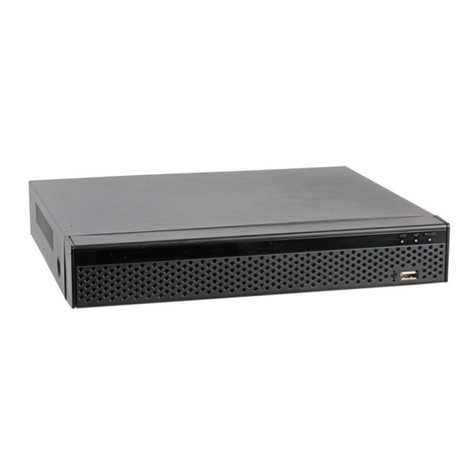
Defender Security
Defender Security DFR-5MP-XBR4V2-BB quick start guide

NETGEAR
NETGEAR ARLO PRO quick start guide

Honeywell
Honeywell Tuxedo Touch manual
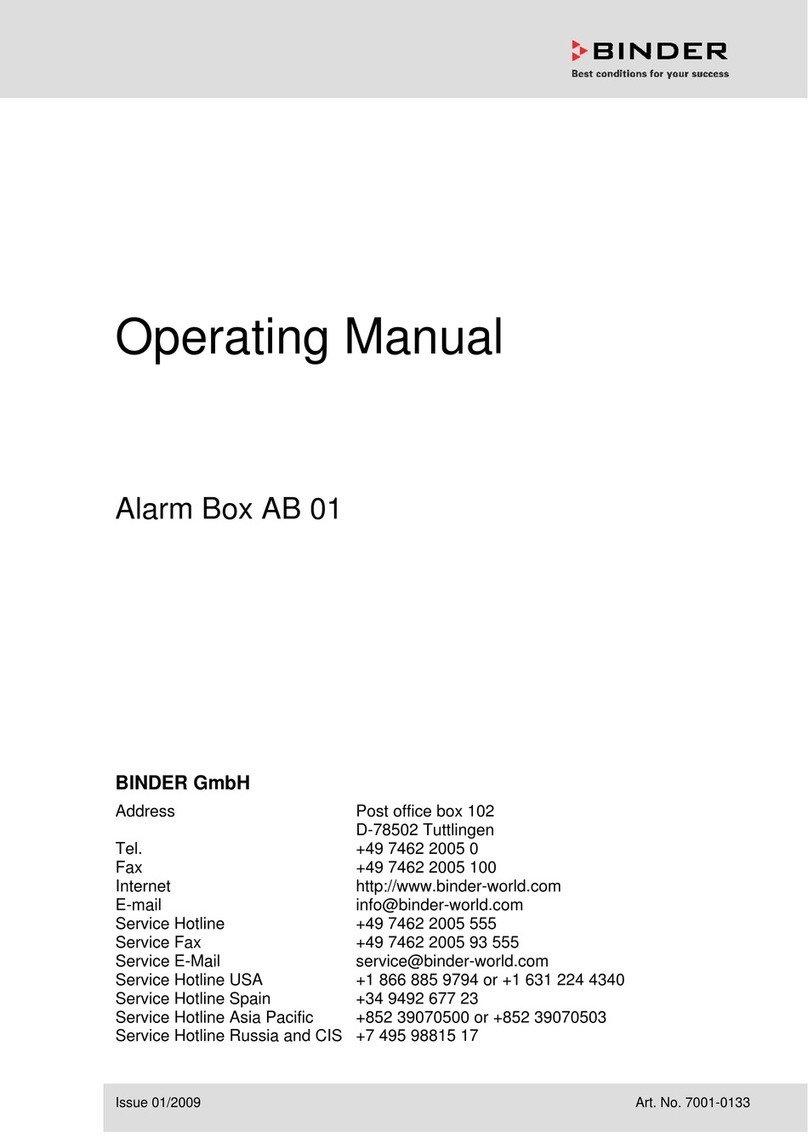
Binder
Binder AB 01 operating manual
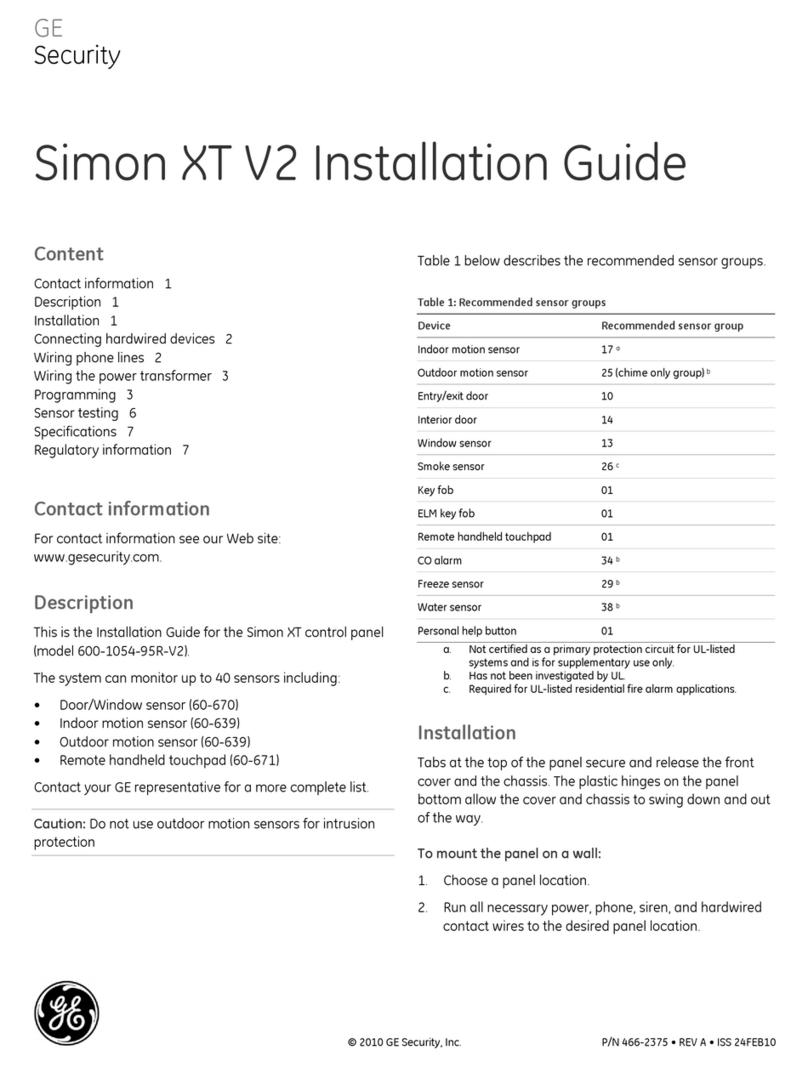
GE Security
GE Security Simon XT V2 installation guide
